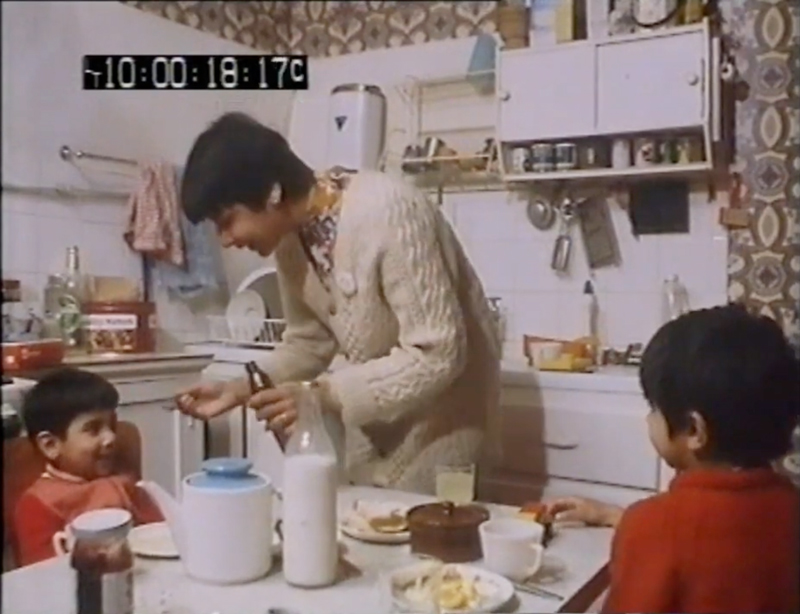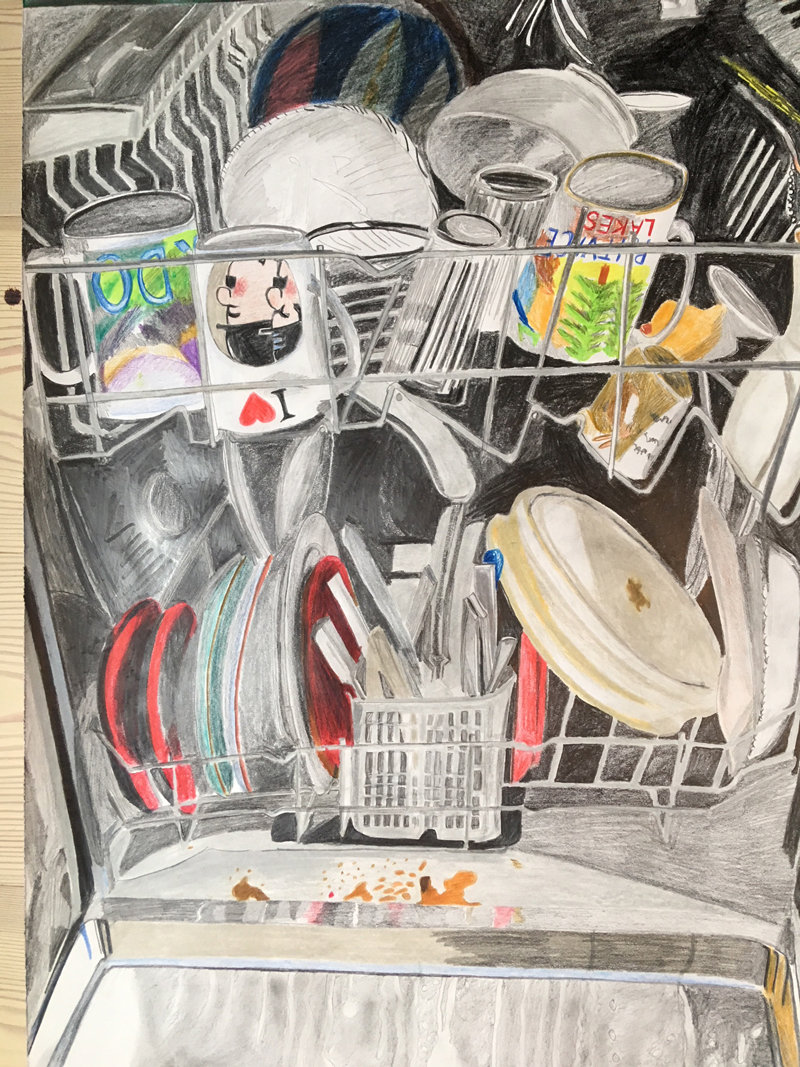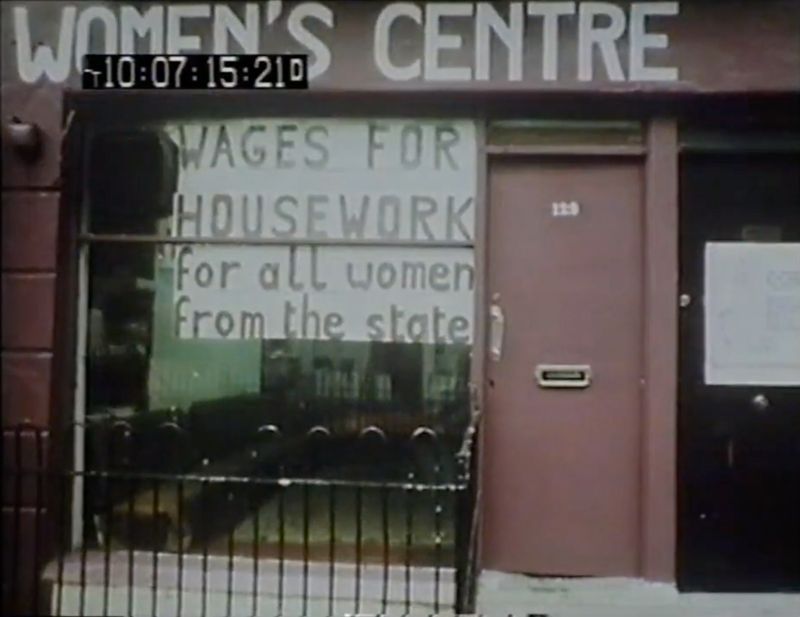
To assemble these thoughts on care and productivity I carved time away from my care-giving responsibilities and my waged work in order to perform more work. The same contradiction lies at the heart of the recent Bodies of Work online film program curated by Benison Kilby for Bus Projects in partnership with Composite. This program builds on Kilby’s impressively researched exhibition at Bus Projects in 2019 of the same name. Consisting of four films from the 1970s and 1980s, drawn from the UK-based feminist film and video archive Cinenova. Over the month of September, in the midst of Melbourne’s stage four lockdown, four films were broadcast for online access. These films expose the gendered exploitation of unpaid or low-paid female workers, and support strategies of collective organisation, solidarity and strike. A program which considers work and its refusal is pertinent at a time when the global pandemic has forced dramatically different labour conditions and speculation about post-work futurity. For artsworkers and artists, these issues are especially contradictory, as the expectations of resilience and adaptability have added new pressures of productivity.
The condition which Marx termed “reproductive labour” is the shared focus of Scuola Senza Fine (1983), Sweet Sugar Rage (1985), All Work and No Pay (1976) and Women of the Rhondda (1973). Alternately known as “the double burden” or “the second shift” as termed by Arlie Hochschild in her book of the same name, reproductive labour refers to the unwaged element of care work: the work we all do and receive – to varying degrees, for ourselves and others – in order to keep on working. The concept follows Marx’s theory that unpaid labour is the structural dependency of capitalism, upon which all cycles of profit and value depend. The subjects of the films – Black Caribbean women working in Jamaican sugar plantations, working-class women in Italy and England, and the housewives of a rural Welsh mining community – perform tasks of invisible maintenance. Agricultural labour, factory work, domestic chores, caring for children and waged workers, scrubbing soot from clothes, are all under-recognised tasks of unending duration.
First broadcast on the BBC in 1976 All Work and No Pay follows the consciousness-raising efforts behind the Wages for Housework Campaign. Led by Mariarosa Dalla Costa, Silvia Federici, and Selma James, the campaign aligned class struggles and feminism to critique the autonomy of production by politicising the unpaid domestic labour performed by housewives. The film documents political campaign strategies, as organisers took to the streets to ask women if they believe that they are entitled to a wage for their housework. In expanding the conception of what can be considered work, the “Wages” campaign also provoked a reconsideration of the commensurability of labour. For feminist scholar Kathi Weeks, the “Wages” treatise can be traced to support for a living-wage of universal basic income. Such a program, she argues, “would not only reduce our dependence on waged work for survival, but would also serve as a kind of support for and recognition of people’s unpaid reproductive labor inside the home.”[1]
All Work and No Pay opens with a scene of a housewife maintaining the endless work of domestic drudgery: preparing food, washing dishes, buttoning coats, feeding children. Set to a folk song written and sung by Wages for Housework member Boo Watson, the chorus is a call for class consciousness: “I can’t keep doing this for free / for there’s too many more women like me”. This scene in particular recalls Manuela Gernedel’s detailed drawings of precariously stacked dishwashers from the 2019 exhibition component of the project. Using pencil, graphite and coloured pens, Gernedel’s series detail the insides of dishwashers, crammed with dirty utensils. Positioned beside the historical second wave feminist battles over unwaged domestic labour, Gernedel’s series signals how efficient inventions such as the dishwasher only maintain the illusion of labour-saving when in fact they simply free up time for other kinds of work. Regarding the gendered division of labour under the current conditions of the pandemic, I read the startling fact that women with paid work outside the home spend just as much time parenting as stay at home mothers did in the 1970s.[2]

In just over one year, the conditions between the Bodies of Work exhibition and recent film program have changed dramatically. I feel solidarity with the housewife in the opening sequence of All Work and No Pay and her endless dishes. As the introductory text to the online program highlights, the last six months have “exacerbated the effects of the double burden of paid and domestic work.”[3] The global pandemic has drawn attention to the precarity of care workers. Low-waged and highly casualised care workers have been without access to sick leave, while being forced to work multiple jobs, and we have seen this play out with disastrous consequences in Melbourne’s aged-care sector. At the same time, care-givers have been affected by the closures of schools and childcare, leading to an increased burden on working parents (mainly women) to look after dependent children – the unpaid work of “reproduction” – while also undertaking paid “productive” work, often in the same work and living space. The multitude of caretaking tasks that were previously obfuscated by the separation between the waged workplace and the privacy of the home, are now recognised for what they are as intercepting and interjecting hours of “productive” labour.
Returning to these debates five decades on during the height of Melbourne’s stage four lockdown begs the question: what did we learn? Or, put another way, what can we no longer ignore? Using tools of community activism including campaigning, consciousness-raising, testimony, collective pedagogy, unionism and calls for a general strike, the women in these films fight for employment and education rights, as well as the recognition and remuneration of their invisible labour. Many of these strategies find counterparts in the contemporary art world, where artists are collectivising, unionising, and enacting mutual aid as measures of support, and in which the current discourses around a general strike and work refusal are fast gaining traction. At the same time, productivity has only accelerated in the face of the pandemic, due to the pressure to produce and maintain digital programs, particularly for those in receipt of JobKeeper. This also puts pressure on artists to produce more, in response to grants and calls for digital initiatives, as persuasively argued by Audrey Schmidt in Memo Review.[4] The anti-work perspective of the Bodies of Work program is a vital response to the current post-Fordist neoliberal economic climate of rampant overwork, over-production and ceaseless reproduction.
What would a refusal of work by the arts sector amount to? What solidarity strategies can be gleaned from feminist battles over the wage to aid us now? How might we adapt collective cultural work practices to avoid performing productivity? Bodies of Work as an ongoing research project could take these provocations into consideration, to account for the position of art organisations in the context of the global health pandemic. Both the program and this text also demonstrate the contradictory position of producing more work – for ourselves, for audiences – at a moment that necessitates rest, reflection and resistance. For all these obvious contradictions, access to these significant films from my own home is valuable. It is at once gratifying and alarming to see the fifty-year struggle for the recognition of domestic labour resonate so clearly at this moment. It feels fitting to watch these films and write this text amidst the chaos of my home, at the kitchen table where my son attends Kinder over Zoom. In swapping one kind of labour for another, I receive a fleeting respite from domestic chores, but of course the work doesn’t diminish and the dishes pile up.

Footnotes
- ^ J. C. Pan, “Love’s Labor Earned”, Dissent Magazine, Winter 2017.
- ^ See Anne Helen Petersen, “How Burnout Became the Norm for American Parents,” New York Times, 22 September 2020.
- ^ Engages, Curated by Benison Kilby, Presented in Partnership with Composite on Bus TV, “Bodies of Work”. Dates: Saturday 5, 12, 19, 26 September, 7pm: https://busprojects.org.au/program/bodies-of-work-online-program.
- ^ Audrey Schmidt, “Lost in the Feed/Translations”, Memo Review, 11 July 2020.
